President Barack Obama’s “pivot to Asia” was supposed to mean that the US would pull back from its commitments in the Middle East and Europe and focus on improving economic and other ties with East Asia. Instead, the US government has helped foment a coup against an elected president in Ukraine, sparking a bloody civil war in the country; ignited a new cold war with Russia, including the imposition of broad economic sanctions; and launched yet another war in the Middle East, this time attacking both Iraqi and Syrian territory.
Fallout from the administration’s turn against Russia (ostensibly in retaliation for what Washington insists is a strong Russian hand in eastern Ukraine’s fight for independence from post-coup Kiev), includes a significant warming of relations between Russia and China and a soaring level of trade between the two countries in Chinese currency, the yuan, instead of the dollar. The result may well be a US own-goal, with the dollar as the global reserve currency soon a faded memory.
Nevertheless, it seems Washington may have decided to execute that pivot after all — while keeping its other foot precariously planted in the Middle East and Europe. But it appears the pivot has begun in an unexpectedly aggressive manner: a US-backed full frontal assault on Chinese rule in Hong Kong.
A student protest in Hong Kong has finished its first week, taking on all the appearances of the numerous US-backed color revolutions that have unseated governments with which Washington has a beef from Georgia to Ukraine to Egypt and beyond. The protesters demand that existing portions of the Basic Law agreed upon when Hong Kong was handed back to China from former British imperial control be changed to allow sooner direct election of the chief executive of the Hong Kong Special Administrative Region.
As with previous color revolutions, protesters represent a tiny minority of the actual population yet they claim to speak with the voice of “the people.”
These voices of the people again seem to have been trained by Washington, however.
As the Moon of Alabama blog has pointed out, the US government-funded National Endowment for Democracy — AKA “regime-change central” — has poured hundreds of thousands of dollars into stoking the regime change flame in Hong Kong. For example, in 2012 alone the US government sent half a million dollars to support these regime-change movements in Hong Kong. Here is the grant listing:
National Democratic Institute for International Affairs
$460,000
To foster awareness regarding Hong Kong’s political institutions and constitutional reform process and to develop the capacity of citizens – particularly university students – to more effectively participate in the public debate on political reform, NDI will work with civil society organizations on parliamentary monitoring, a survey, and development of an Internet portal, allowing students and citizens to explore possible reforms leading to universal suffrage.
In addition, Joshua Wong, the 17 year-old leader of main student group Scholarism has been accused of maintaining close US government ties, including regular meetings at the US Consulate in Hong Kong.
The US Consulate and other US government bodies also fund the Hong Kong-America Center, which is run by a former US diplomat and brings Chinese students to the United States to “study” about democracy (and perhaps how to launch a color revolution?). The Ford Foundation, long associated with the US Central Intelligence Agency, is also a major sponsor of the organization’s student exchange programs.
As pointed out by color revolution observer Tony Cartalucci, leaders of the main Hong Kong protest group, Occupy Central, have long ties to US government regime change money. Writes Cartalucci:
Occupy Central’s self-proclaimed leader, Benny Tai, is a law professor at the…University of Hong Kong and a regular collaborator with the NDI-funded Centre for Comparative and Public Law (CCPL)…
Recent events in Hong Kong follow a pattern of US-engineered regime change operations, where naive students and other youth are encouraged to be the public face of protests, which start out preaching non-violence only to be very soon shunted aside by far more radical elements who provide the real muscle behind the regime change. This happened in Egypt, with the US-sponsored April 6 Movement, it happened in Syria with the initial peaceful protests soon taken over by armed (and also US-backed) radicals, and it happened in Ukraine, where the Maidan protests soon gave way to violent, armed groups sporting neo-nazi tattoos and radical ideologies.
If the pattern is repeating in Hong Kong, we will soon see an uptick in violence, meant to provoke authorities into a crackdown. This will be followed by strong condemnation from the United States government, which urges foreign authorities to refrain from what US police routinely do during such situations: exercise extreme violence. US sanctions may follow if the situation can approach terminal velocity.
And, because Color Revolutions 2.0 have adopted extreme violence as a critical element, look for a great deal of bloodshed. Finally, some observers have said that the Chinese government would never let this situation get out of hand. Don’t be fooled. The exercise is well practiced. The sclerotic Chinese authorities will likely not see what has hit them. Nobody expects regime change.

